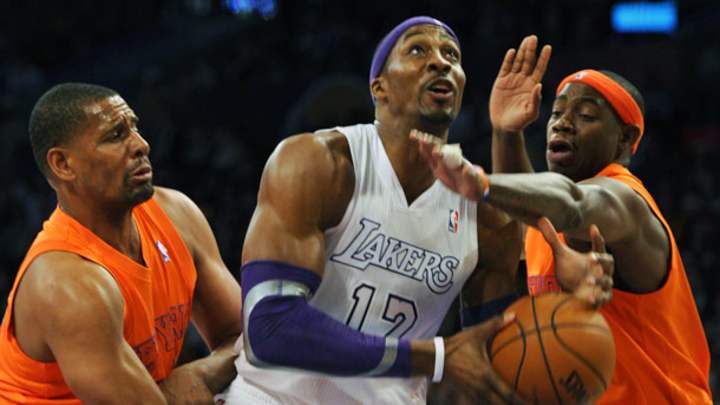Three-Pointers: Howard and the Lakers contain Knicks' high-powered offense

Dwight Howard's 14 points and 12 rebunds helped the Lakers win their fifth straight game. (Lori Shepler/Landov)

By Rob Mahoney
In a matchup of the NBA's two glitziest franchises, a cast of big-name stars didn't disappoint. Neither the Lakers nor the Knicks held a double-digit lead in their Christmas Day game, and good execution by both teams bore a riveting, tit-for-tat finish and a 100-94 win for Los Angeles. Kobe Bryant matched Carmelo Anthony's 34 points, and Pau Gasolhad a game-sealing dunk for the Lakers, who moved back to .500 with their fifth consecutive victory.
• For all of the talk about Gasol's fit in Mike D'Antoni's offense or the playmaking deficit created by Steve Nash's recent absence, the Lakers' greatest difficulty this season has been to execute a cogent defensive strategy. But many of those problems were alleviated on Tuesday -- if only within the context of this specific matchup. Some scrambling on the perimeter helped make manageable the output of New York's top scorers. Good weak-side awareness prevented easy interior scores. And most importantly: D'Antoni and his staff positioned Dwight Howard perfectly in their pick-and-roll defense, fully aware of how crucial Raymond Felton's penetration is to New York's offense.
By having Howard sink all the way back to the free-throw line (or in some cases, even deeper) in an effort to bind Tyson Chandler, the Lakers took away the most efficient result of the Knicks' high screens while also denying Felton the opportunity to get all the way to the rim. Felton essentially had two choices, provided that the Lakers' point guards didn't recover in time to take them away: a pull-up jumper that L.A. would surely live with, or a difficult runner that Howard could still alter.
The Knicks' offensive spacing created enough elbow room to reduce the impact of the other three Lakers defenders, but Howard's judgment in reading Felton's intentions was virtually flawless. He's still physically limited by an ailing back, but Howard understands where and how offenses look to create scoring opportunities and isn't easily duped by fakes or hesitations. From the second that Felton wheeled around Chandler's screen, Howard was ready to defend against every one of the Knicks' interior options and prepared to concede long floater after long floater for the sake of long-term defensive process. The approach paid off handsomely; in trusting his best defender to make judgment call after judgment call, D'Antoni created the foundation for a defense that enabled inaccurate intermediate attempts from Felton (who finished 5-of-19 from the field), held Chandler to just six points and cut off the contingency options accessed through high pick-and-roll play.
• The Lakers may have largely dictated the game's terms (as far as matchups and strategy, if not always on the scoreboard), but that hardly stopped the Knicks from making this an exciting affair from buzzer to buzzer. Credit for that feat mainly goes to Anthony (34 points on 23 shots) and J.R. Smith (25 points on 23 shots) -- those resourceful scorers who were able to generate points from broken plays and score despite good defensive coverage. Such natural bucket-getters are the fundamental difference between an offense that's merely well-designed and one that's altogether sound. As much as balanced, team-centric play action fuels a team's overall success, great offensive outfits rely on the individual dynamism of high-volume creators to bridge the gaps in their production.
Anthony has solidly established himself as just such a resource this season, and Smith has that same capacity for improbable offense. Neither should be able to convert the deep three-point attempts or tough, turnaround jumpers that they do, but their disregard of the improbable is in part what makes New York's offensive potential so great. A careful balance needs to be maintained so that Anthony, Smith or even Felton doesn't take the offense off the rails voluntarily, but such talented shot creators hold a significant influence on the overall flow of the Knicks' offensive pursuits.
• Opposite the Knicks was a team that all too often falls on the wrong side of that individual-team offensive balance in crunch time. L.A. has a bad habit (reinforced by natural pecking order and Howard's poor shooting from the free-throw line) of ceding complete control of its late-game offense to Bryant's whims, a strategy that empirically has bogged down potent Lakers offenses into self-created inefficiency. But in this game, Bryant relinquished his stranglehold on the Lakers' endgame operation. Kobe willingly played off the ball in a situation where he typically would have cleared out his side of the floor for a pull-up jumper; he set a crucial pin-down screen that allowed Gasol (who not only played in crunch time but also thrived) to attack the basket; he spaced the court and provided a threat that the Knicks had no choice but to account for, thus giving the Lakers' offense the balance it needed to execute real plays when it needed points most.
